Understanding the Energy Crash After Eating & How to Prevent It
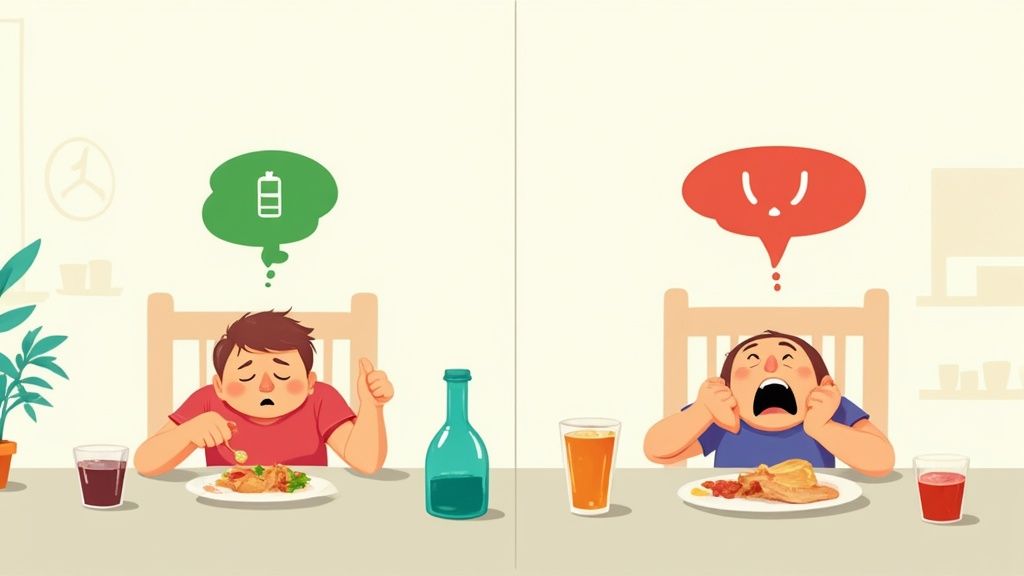
You know that feeling. The one where you're ready to curl up for a nap right under your desk after lunch? That’s the classic energy crash after eating.
This all-too-common experience, sometimes called postprandial somnolence or a "food coma," isn't just a sign that you ate a big meal. It's your body's direct reaction to what you ate—especially meals packed with sugar and refined carbs.
Why Do You Get a Food Coma?
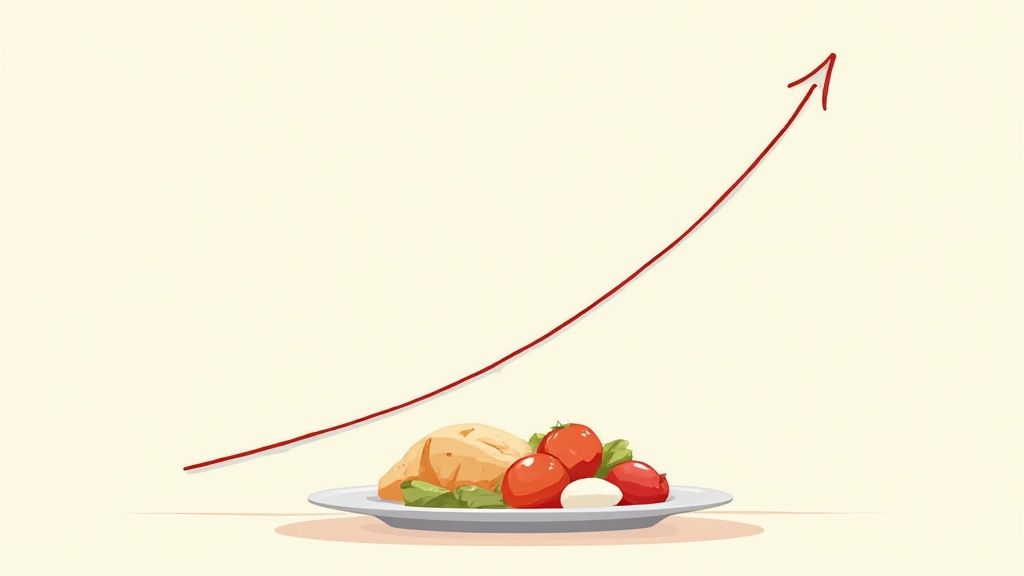
Ever feel like you were on top of the world, only to have your energy completely drain away after eating? It’s not in your head. There’s a real physiological process at work.
Think of your body's energy system like a campfire. If you add logs (a balanced meal with protein and fiber) one at a time, you get a steady, consistent flame that burns for hours. But if you douse the fire with lighter fluid (a meal high in sugar and simple carbs), you get a huge, immediate flare-up that quickly dies down, leaving you with nothing but smoldering embers.
That's essentially what happens inside your body. When you eat a meal loaded with sugar, your bloodstream gets a massive, sudden flood of glucose. This is the "sugar rush" that might give you a brief burst of energy. To handle this emergency, your pancreas scrambles to release a huge amount of insulin, the hormone responsible for moving that glucose out of your blood and into your cells.
But here’s the problem: this panicked response is often an overcorrection. The rush of insulin can pull too much sugar out of your blood, causing your levels to plummet. That sudden drop is the "crash."
This blood sugar rollercoaster—a sharp spike followed by a steep nosedive—is the main culprit behind that post-meal fog and fatigue. Your brain, which needs a constant supply of glucose to function properly, is suddenly running on empty. The result is that familiar collection of symptoms we call an energy crash after eating.
The Telltale Signs of a Post-Meal Crash
Figuring out if you're experiencing a food coma is the first step to avoiding one. While it feels a bit different for everyone, it’s usually more than just feeling a little drowsy.
Look out for these classic signs:
- Sudden, Overwhelming Fatigue: An intense wave of sleepiness that makes it nearly impossible to focus.
- Brain Fog: You find yourself struggling to concentrate, remember simple things, or think clearly.
- Irritability: Little things start to get on your nerves, and you feel moody for no apparent reason.
- More Cravings: Your body, desperate to fix the low blood sugar, starts screaming for more sugary snacks.
This cycle is exactly why grabbing a cookie to fight the 3 PM slump is a losing battle. You're just setting yourself up for another quick spike and an even more miserable crash, trapping you in a frustrating loop. Once you understand what’s really going on, you can start making choices that keep your energy steady and predictable all day long.
How Your Meal Choices Trigger Fatigue
Ever wonder why some meals leave you feeling ready to take on the world, while others have you scouting for the nearest couch? It all comes down to what's on your plate.
Imagine your body's energy system. A grilled chicken salad with fresh veggies is like a slow-burning log in a fireplace—it provides steady, reliable heat for hours. A donut, however, is like a flash of gunpowder. You get a quick, bright burst of energy, but it's gone in an instant, leaving you with nothing.
This isn't just a clever analogy. It's exactly how your body processes different foods. Let's look at the primary culprits behind that dreaded afternoon slump.
High-Sugar Carbs: The Quickest Path to a Crash
Simple and refined carbs are the number one trigger for an energy crash after eating. Think sugary drinks, white bread, pasta, and most desserts.
When you eat these, your body converts them into glucose (sugar) almost immediately. This floods your bloodstream, causing a massive sugar spike. In response, your body releases a flood of insulin to get that sugar out of your blood, but it often does its job a little too well. The result? Your blood sugar plummets, and that sudden drop is the "crash" you feel.
Foods with a high glycemic index are masters of this spike-and-crash cycle. To really get a handle on this, you can dig deeper into what is glycemic index and how different carbs stack up.
Heavy Fats And Processed Foods: The Slow Drain
Sugar gives you a fast track to fatigue, but other foods can drain your energy on a slower timeline. Meals loaded with unhealthy fats and processed ingredients are notorious for this.
High-fat foods—especially fried foods, creamy sauces, and processed meats—are tough for your body to break down. They require a ton of digestive energy, which means resources are pulled away from your brain and muscles. The end result is that heavy, sluggish feeling.
The image below shows just how common this is, and how quickly simple carbs can bring on the slump.
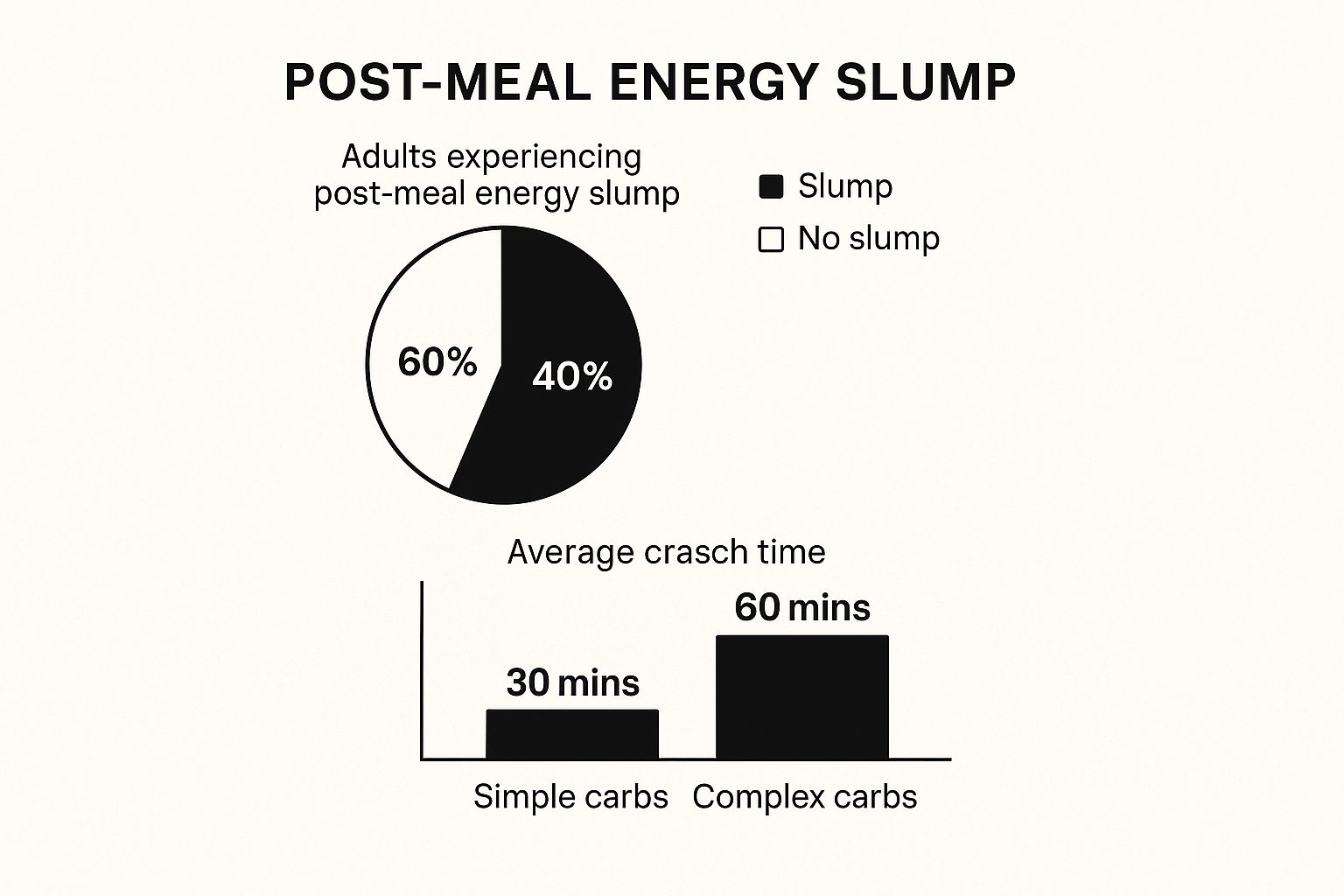
It’s clear from the data that while over 60% of adults regularly feel tired after eating, the type of food determines how fast that fatigue hits.
Highly processed meals make matters worse. They're often stripped of the fiber and nutrients that help regulate digestion and energy. For a real-world example of a high-sugar food guaranteed to cause a crash, just look at this classic pavlova recipe.
To make this crystal clear, here’s a simple breakdown of how different foods set you up for success or a slump.
How Different Foods Impact Your Energy
This table breaks down how common food types affect your body, showing which ones are most likely to cause a post-meal energy crash.
| Food Type | Blood Sugar Response | Typical Energy Outcome | Common Examples |
|---|---|---|---|
| Simple/Refined Carbs | Rapid spike, followed by a sharp crash. | A quick burst of energy, then deep fatigue and brain fog. | White bread, pasta, candy, pastries, sugary drinks. |
| Complex Carbs | Slow, gradual rise in blood sugar. | Steady, sustained energy over several hours. | Brown rice, quinoa, oats, beans, sweet potatoes. |
| Lean Protein | Minimal impact on blood sugar. | Long-lasting satiety and stable energy. | Chicken breast, fish, tofu, Greek yogurt, lentils. |
| Heavy Fats & Processed Foods | Can cause a delayed, but significant, energy drain. | Sluggishness and sleepiness as the body works hard to digest. | Fried food, fast food, creamy sauces, processed meats. |
As you can see, balancing your plate with the right kinds of foods is the key to avoiding that post-meal exhaustion.
Key Takeaway: A meal's impact on your energy isn't just about calories. It’s about how your body has to work to process it. Fast-burning carbs and hard-to-digest fats are a guaranteed recipe for an energy slump.
The Hidden Energy Drain of Processed Foods
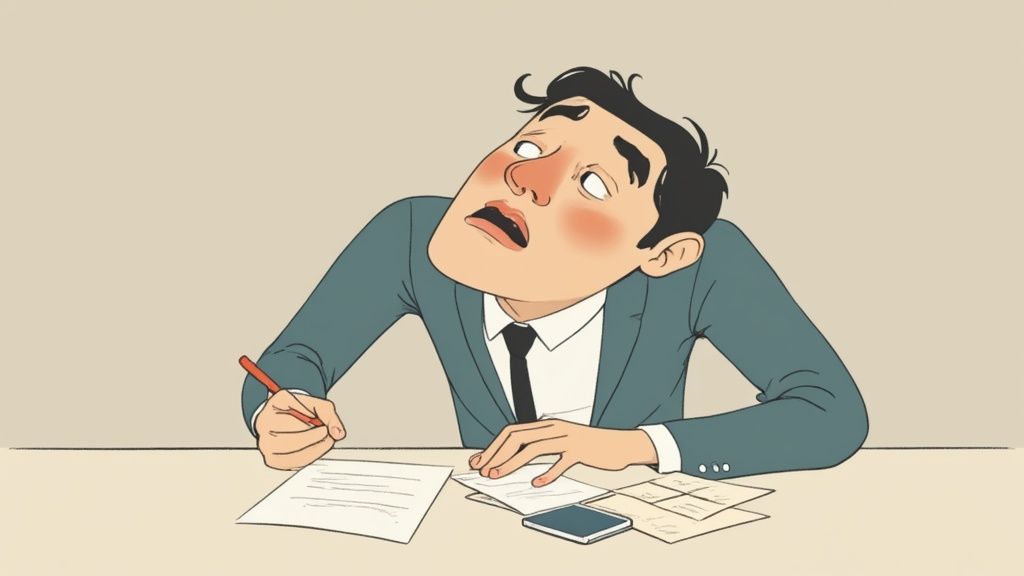
It’s not always about the obvious sugar rush and crash. Sometimes, the reason you feel so drained after a meal is a bit more subtle, hiding in plain sight in things like frozen dinners, packaged snacks, and other highly processed foods.
The secret lies in a concept called the Thermic Effect of Food (TEF). Simply put, TEF is the energy your body spends just to digest and absorb the food you eat. It’s like a mini-workout for your digestive system.
Every food requires a different amount of effort. Whole, unprocessed foods—think a fresh salad, a piece of grilled chicken, or a bowl of oatmeal—are complex. Your body has to really work to break them down, and this effort fires up your metabolism and burns energy.
The Problem with “Easy” Foods
Processed foods are the exact opposite. They’ve been so refined and broken down in a factory that your digestive system barely has to lift a finger. They’re stripped of fiber and pre-digested, making them incredibly easy for your body to absorb.
While that might sound efficient, it’s not great for your energy. Your metabolism basically goes into low-power mode because there’s no real work to do.
One eye-opening study showed that the body's energy use after a processed meal was almost 50% lower than after a whole-food meal, even when the calories were identical. That metabolic slowdown is a huge reason for that sluggish, heavy feeling. You can dive deeper into how processed foods affect metabolism in the full study.
The bottom line is this: When your body doesn't have to work to digest its fuel, your internal engine just idles instead of revving up. The result? A noticeable drop in your get-up-and-go.
This is exactly why a 500-calorie meal of grilled salmon and veggies can leave you feeling sharp and ready to go, while a 500-calorie fast-food meal often leads to an energy crash after eating.
On top of that, many of these convenient foods are loaded with sugar. To keep your energy stable, it’s a good idea to learn about the common culprits of hidden sugar in foods. By choosing foods that give your body a bit of a workout, you’re not just getting better nutrition—you're actively fueling a more energetic you.
Why Meal Size and Timing Are Critical
We've talked a lot about what you eat, but how much and when you eat are just as important. The size of your meals and when you have them can be the difference between feeling energized and hitting a wall.
Think of it this way: your digestive system is like a small, dedicated team. If you drop a mountain of work on them all at once, the whole operation is going to slow to a crawl. That’s exactly what happens when you eat a huge meal.
Your body has to divert a massive amount of blood and energy to your gut just to start breaking everything down. This pulls resources away from other places, like your brain, leaving you in that familiar state of mental fog and physical exhaustion. Suddenly, a nap sounds like the only logical next step because your body is tied up with the colossal task of digestion.
The Real-World Impact of Overeating
This isn't just a feeling, either. It has a real, measurable impact on your ability to function.
One study perfectly illustrates this. Researchers compared drivers who ate a light lunch to those who ate a heavy one. The heavy meal, with three times the calories, caused drivers to drift out of their lanes four times as often. That's a huge dip in alertness that can stick around for hours. You can read more about how meal size affects alertness on Healthline.com.
The takeaway here is that overeating doesn't just make you feel a bit sleepy. It can genuinely impair your thinking and slow your reaction time. That post-lunch slump isn't just an inconvenience—it can be a real risk.
Key Insight: A large meal forces your body into "digestive overdrive." It has to prioritize breaking down food over everything else, including your mental clarity and physical energy, which is a direct cause of post-meal fatigue.
The Solution: Smaller, More Frequent Meals
So, what's the fix? Instead of three massive meals that send your system into shock, try switching to four or five smaller, balanced meals spread throughout the day.
This simple change keeps your digestive system from getting overwhelmed and helps keep your blood sugar on a much more even keel.
You're giving your body a steady, manageable trickle of fuel, which helps you avoid the dramatic hormonal spikes and energy drains that come with giant meals. It’s a powerful strategy for maintaining consistent energy all day long, helping you stay sharp without having to completely overhaul your diet. This one shift can be a game-changer for preventing an energy crash after eating.
Your Action Plan to Prevent Energy Crashes
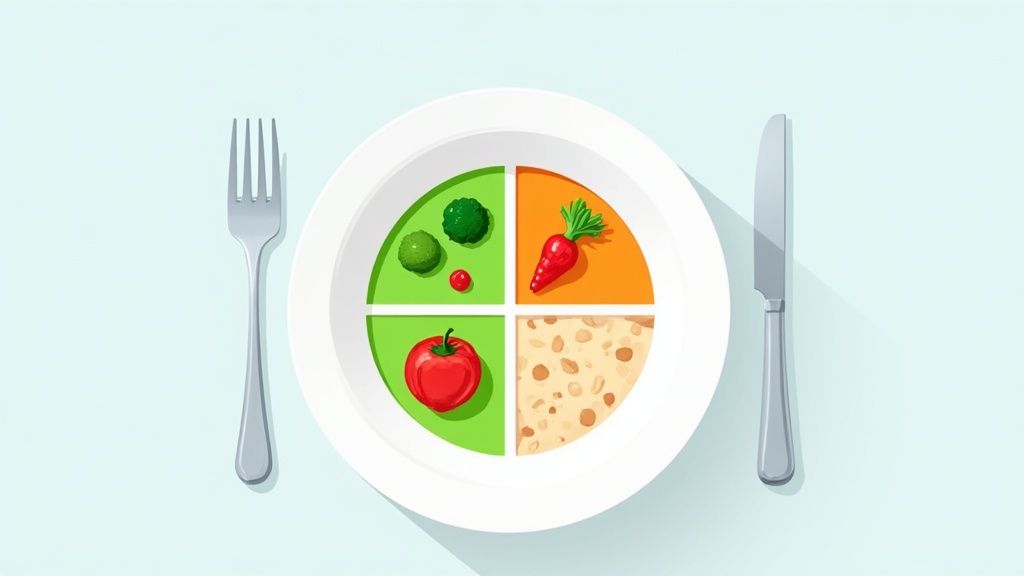
Knowing why you crash after a meal is one thing, but actually doing something about it is where the real magic happens. The best part? You don't need to go on some crazy restrictive diet. It’s all about making smarter choices about how you build your meals and structure your day.
Think of this as your personal toolkit for steady, predictable energy. These are practical, easy-to-implement strategies designed to help you finally get a handle on that dreaded post-meal slump for good.
Build a Balanced Plate
Your fork is your most powerful weapon against the afternoon slump. Seriously. The goal is to build every meal around a "power trio" of protein, fiber, and healthy fats. This combination is your best defense against the blood sugar rollercoaster.
Here’s a quick breakdown:
- Lean Protein: Think chicken, fish, tofu, or lentils. Protein slows down digestion, which means the carbs you eat get absorbed much more slowly. No sudden sugar rush, no sudden crash.
- High-Fiber Carbs: This is where you swap white bread for things like quinoa, sweet potatoes, brown rice, and beans. Fiber acts like a brake pedal for sugar, ensuring a slow, steady release into your bloodstream for energy that lasts.
- Healthy Fats: Avocado, nuts, seeds, and a drizzle of olive oil do more than just add flavor. They also slow down nutrient absorption and help you feel full and satisfied, keeping you energized for hours.
Nailing this simple formula is the foundation for learning how to stabilize blood sugar levels and maintain all-day energy.
The Anti-Crash Meal Builder
Use this simple guide to construct meals that provide sustained energy and help you avoid the afternoon slump.
| Component | What to Add | Why It Works | Quick Example |
|---|---|---|---|
| Protein | Chicken, fish, tofu, beans, lentils, Greek yogurt | Slows carbohydrate absorption, preventing rapid sugar spikes. | Grilled chicken breast |
| Fiber | Quinoa, brown rice, sweet potato, broccoli, leafy greens | Slows the release of glucose into the bloodstream. | A side of roasted broccoli |
| Healthy Fat | Avocado, nuts, seeds, olive oil | Increases satiety and further slows digestion. | Half an avocado, sliced |
Putting it all together gives you a meal that's not just delicious but also engineered to keep you feeling great.
Hydrate and Move Your Body
What you do around your meal is just as important as what's on your plate. Two of the easiest and most impactful habits are staying hydrated and getting in some light movement.
Feeling sluggish and foggy? You might just be dehydrated. Drinking plenty of water is crucial for your body to transport nutrients efficiently and keep your energy up.
A quick 10-minute walk after eating can do wonders. It encourages your muscles to soak up the glucose from your meal, which helps lower your blood sugar naturally and prevents the insulin over-response that triggers a crash.
Adopt Mindful Eating Habits
Finally, zoom out a bit. It’s about more than just food; understanding how lifestyle and diet changes can impact your overall well-being is key.
Simple habits can make a huge difference. Try slowing down, putting your fork down between bites, and chewing your food thoroughly. This gives your brain time to get the "I'm full" signal from your stomach, which helps you avoid overeating and overwhelming your system.
These small tweaks, when combined with balanced meals, create a powerful system to prevent that energy crash after eating and keep you focused all day long.
Still Have Questions About That Post-Meal Slump?
Even when you know the basics, a few questions always seem to come up as you start paying closer attention to how food affects your energy. Getting clear on the little details can make all the difference in feeling confident about your choices.
Let's walk through some of the most common questions people have about that dreaded energy crash after eating. Think of this as your go-to reference for clearing up any confusion.
If I Crash After Eating, Does That Mean Something Is Wrong With Me?
Not usually, no. Feeling a little sluggish after a huge, carb-heavy meal is a perfectly normal biological response. Your body is just kicking its digestive system into high gear, and the hormonal shifts that come with it can make you feel sleepy. It just means your body is working as it should.
But here's the catch: if these crashes are happening all the time, feel really intense, or come with other signs like dizziness, shakiness, or extreme irritability, it’s a good idea to talk to a doctor. While it's often just about the food, persistent crashes can sometimes point to underlying issues like insulin resistance or reactive hypoglycemia. It's always better to get things checked out and have peace of mind.
Can I Still Eat Carbs and Avoid the Food Coma?
You absolutely can! The goal isn't to get rid of carbs entirely—it's to get smarter about which ones you choose and how you eat them. This whole "carbs are the enemy" idea is a myth that just leads to diets that are too hard to stick with.
The real secret is to switch from simple carbs to complex ones. Here’s a simple way to think about it:
- Simple Carbs: Things like white bread, sugary drinks, and pastries are like kindling for a fire. They burn up incredibly fast, giving you a quick burst of heat followed by nothing.
- Complex Carbs: Foods like quinoa, sweet potatoes, beans, and whole grains are like big, dense logs. They burn slow and steady, providing reliable energy for hours.
And the most important tip? Always pair your carbs with some protein and healthy fat. Adding grilled chicken to your pasta or a handful of almonds to your oatmeal changes everything. That combination is your best defense against a blood sugar nosedive.
How Soon After a Meal Does the Energy Crash Usually Happen?
For most people, that sleepy, foggy feeling really hits its peak somewhere between 1 to 2 hours after eating. This timing isn’t random—it lines up perfectly with how your body manages blood sugar.
When you eat a meal (especially one full of sugar), your blood glucose levels rise. Your pancreas then sends out insulin to help move that sugar into your cells for energy. But sometimes, especially after a sugar bomb, your body overreacts and sends out a little too much insulin. This causes your blood sugar to drop too low, too fast, and that sudden dip is the "crash" you feel. Of course, the exact timing and how bad it feels depends on your own metabolism and exactly what you ate.
Pro Tip: If you notice yourself getting drowsy right around the 90-minute mark after lunch every day, take that as a clue. It's a strong signal that your meal wasn't quite balanced. Use that feedback to tweak your next meal by adding more protein or fiber.
Is Coffee a Good Fix for Post-Meal Drowsiness?
Grabbing a coffee when you feel a crash coming on might feel like the right move, but it’s really just a temporary patch. The caffeine will give you a short jolt, sure, but it does nothing to fix the real problem: the blood sugar roller coaster you’re on.
Worse yet, if you’re adding sugar or sweet creamers, you’re just kicking off another cycle. You'll get a quick lift followed by an even bigger crash a couple of hours later. It’s a frustrating pattern to get stuck in.
A much better approach is to prevent the crash in the first place with a well-balanced meal. But if you do need a little pick-me-up, try a brisk 10-minute walk instead of caffeine. A little movement helps your muscles soak up the sugar in your bloodstream, which can clear the fog and boost your energy without any of the downsides.